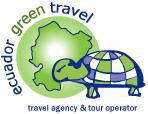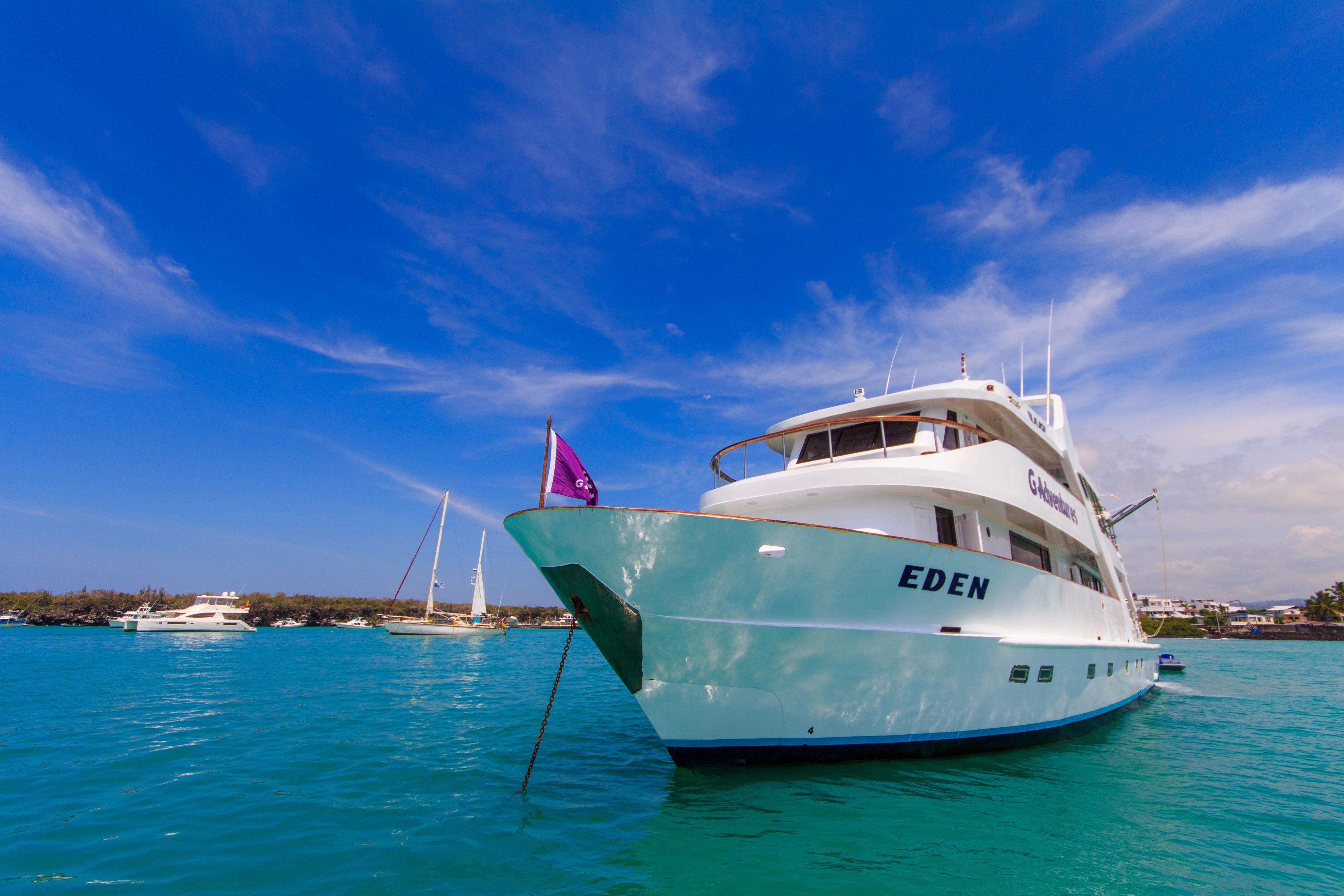DAY 1: TUESDAY, SANTA CRUZ (INDEFATIGABLE)
AM: BALTRA AIRPORT
On arrival at Baltra Airport all visitors pay their entrance fee to the Galapagos National Park, pass through immigration control, purchase their bus tickets, claim their checked pieces and get their hand luggage checked by the Galápagos Biosecurity Agency (ABG also known as our Quarantine system). The Samba’s naturalist guide will assist you with as you come out of the terminal and accompany to the bus.
We travel on LOBITOS (bus company) to the south end of the Island (7 minutes ride). We cross the Itabaca Channel on a small ferry (barge) to land on the north coast of Santa Cruz. We embark on another bus to travel through the Island and visit the highlands. We stop at El Chato 2 (private tortoise reserve) and have lunch around 13:00.
It is strongly recommended to wear appropriate gear for this visit to the Highlands. Because the area is under constant influence of moisture is likely to be muddy and humid. Pants, proper shoe wear and a rain jacket are a must.
After spending quality time with our gentle giants and walking through a lava tunnel we travel on our bus to Puerto Ayora. In town guests have a few minutes to walk by the main street before we head to the Samba. We will be on board around 17:30 and dinner will be around 19:00.

DAY 2: WEDNESDAY, FLOREANA (CHARLES)
AM: PUNTA CORMORANT & CHAMPION
Following a four-hour navigation from Puerto Ayora we will do a wet landing on a volcanic olivine beach. Punta Cormorant lays on the northern shore of Floreana and is the house of greater flamingos and sea turtles. On one side, the point is partially flooded with a brackish lagoon where flamingos nest and feed. Whimbrels, herons and stilts are other common shore and migratory birds of the wetlands. On the other side sea turtles use every corner of a white sand beach to deliver their eggs. You often see stingrays and reef sharks from the shore and if you are lucky turtles ending basking.
PM: POST OFFICE BAY & THE BARRONESS LOOKOUT
Around mid morning we sail for 25 minutes do a dinghy ride and snorkel at Champion Islet. This small piece of land is one of two places were the Floreana mocking bird survives after its extinction on the big Island. While trying to find the rare bird from our dinghies, we will enjoy a beautiful landscape full of fairy tale cactus and terracotta rock formations. Soon sea lions will invite us to enjoy the water. The snorkeling around the island is extraordinary, lots of fish, rays, sharks and the playfulness of the Galapagos sea lions.
Adventure, survival, mystery and murder are the main ingredients for our next stop. Post Office Bay has left a legacy of pirates, whalers, scientific expeditions and intense stories of slay and constant ambiguity. After a wet landing we walk a very short distance to be part of the most important Galapagos tradition. Later we will Kayak or ride our dinghies to the west. We will go through a small set of islets with a sea lion colony, boobies and mangroves. Finally, following our ride we will land at the Baroness lookout. On top of this eroded spatter cone we will embrace the vivid obscurity of the human history of “Las Encantadas”.

DAY 3: THURSDAY, ESPAÑOLA (HOOD)
AM: PUNTA SUAREZ
Hood is the oldest Galapagos Island, the Queen. Her Majesty has travel 100 miles away from the volcanic hotspot; she sets an example of splendor and wisdom. When landing on its western tip, on Punta Suárez, it is difficult to digest the beauty and the overwhelming amount of life. It takes a few minutes to understand that you are not dreaming and that the marine iguanas are really covered with fiery colors, sea lions leisurely wander around you, blue-footed boobies and Sally light-foot crabs coat the rocks with their intense grace. The long walk leads you the finest illustration of ancient sea bird colony. The endless cliff shaped by strong wave action and the force of the wind is the home of the only tropical albatross of the Earth. This mythical elegant glider shares the precipice with many others sea birds like the tropicbirds, the sallow tailed gull, the Nazca booby.
PM: GARDNER BAY & GARDNER ISLAND
Depending on weather conditions, either at the end of the morning or early in the afternoon, we will snorkel or kayak around Gardner Island. Its calm waters and attractive landscape give you a great experience above and below water.
Located on the north coast of Española Gardner Bay has tranquil white sand beach. The fine grains of sand make perfect terrain for a soft walk and a relaxing late in the afternoon. Don’t get me wrong, you won’t be alone, sea lions and Hood mocking birds will keep company.

DAY 4: FRIDAY, SAN CRISTOBAL (CHATHAM)
AM: ISLA LOBOS & KICKER ROCK
You will wake up to the barking of Galapagos sea lions, animals after which the Island was named. After a dry landing on Isla Lobos, we walk on over very rocky terrain. To your surprise red balloons will soon bound you, great and magnificent pirates nest on this small flat Island. Frigate birds with their magenta and green iridescent feathers decorate the saltbushes. The island is also the nesting ground of blue-footed boobies. Don’t miss the chance of swimming with sea lions; a few sea creatures are as playful as these marine mammals.
Before lunch we navigate by a dramatic tuff cone formation, Kicker Rock. The eroded structure has vertical walls of over 450 feet and has a great numbers of sea birds nesting and resting on it. We will circumnavigate the rock to admire its magnitude, soon after that we will jump in the water to swim with Galapagos sharks, sea turtles, and eagle rays and drop offs full of colorful fish and invertebrates.
PM: PUNTA PITT
On Punta Pitt we do a wet landing late in the afternoon to climb a tuff cone and enjoy the sunset. This point is closest to mainland South America. Nazca boobies, red-footed boobies, frigate birds and storm petrel nest in the area. The ochre color beach is perfect for a relaxing plunge after the walk.

DAY 5: SATURDAY, SANTA FE & PLAZAS
AM: BARRINGTON BAY
The bay looks as if artist ornamented it. Barrington Bay is one of the most picturesque inlets of all visitor sites of the Galapagos. The white sand on the seabed reflects the light to turn the calm waters turquoise. A small forest of gigantic prickly pear cactus grows on a peninsula that keeps the bay sheltered. All the before mentioned are suitable conditions for a large sea lion colony. Santa Fe is an ancient extinct volcano and it has been isolated from other island long enough to have an endemic land dragon. Paler in color than its relatives, the Barrington terrestrial iguana has a primitive morphology. Galapagos Hawks, mocking birds, finches and endemic rice rats make company to yellowish monster. The snorkeling won’t disappoint you.
PM: SOUTH PLAZA & PUNTA CARRION
A two-hour navigation north will take us to South Plaza. The dry landing takes you to a brilliant combination of life and colors. Land iguanas wondering through bright red carpet weed, Swallow tailed gulls nesting around the overhang tops and red-billed tropicbirds and shearwaters flying with dancing displays. Mind the pirates of the sky; they will strike if you drop your guard. 13 acres of beauty Hectare is one of the best spots in the archipelago to see land iguanas and swallow-tailed gulls, both indigenous to the Galapagos. There are iguana nests scattered all over the hill. The sheer cliffs of the southern shore are a perfect bird habitat, making it an unparalleled bird observatory for especially swallow-tailed gulls, Audubon shearwaters, and red-billed tropicbirds.
If we have enough time and good weather we will swim or snorkel in Punta Carrion. A great way to end an active day!

DAY 6: SUNDAY, SANTIAGO & BARTOLOME
AM: SULLIVAN BAY
The genesis of the islands is easy to acknowledge at Chinese Hat. The coiled shiny structures of the pahoe-hoe lava appear as if they were formed yesterday. Lava tubes run like petrified rivers and white sand from eroded coral surrounds the black rock, scenic falls short. Located on the Southeast shores of James this Island is a very symmetrical cinder cone. The contrast of colors and shapes of the basalt, rust and shine of its surface will take you travel back to Mars, if you’ve been there before. Did someone say penguins? We love snorkeling here
PM: BARTOLOME
Bartolome Island offers an explosive volcanic landscape. Get ready to climb above 270 feet to admire the dramatic spatter cones and the view of Pinnacle Rock that everyone wants. Later, take a walk on magical golden beaches where sea turtle nest (December to March). Don’t forget to make time to swim near penguins, sharks and lava tubes.

DAY 7: MONDAY, JAMES & RABIDA (SANTIAGO)
AM: JAMES BAY
James Bay, also known as Puerto Egas, has magical shorelines that combine tuff cone, lava flows and organic sand. A rocky coast with a very gentle slope is used by a great number of shore birds and reptiles. Oystercatchers, whimbrels, sanderlings, turnstones, tattlers and other waders are mixed with marine iguanas and bright painted crabs to feed by the rich littoral zone. As grand finally, large lava tunnels, that are partially collapsed, are the houses of the Galapagos fur sea lions. The snorkel can be one of the best in the archipelago. Sea turtles feeding, parrot fishes, damsel fishes, white tipped reef sharks and many more…
PM: RABIDA
Galapagos offers a diversity of geological formations without boundaries. The island of Rábida has lavas rich in iron and after millions of years of exposure to air they have turned red. The rusted volcanic material has eroded to form a beautiful crimson sand beach, lovely for a walk. The protected shore provides excellent conditions for a Galapagos sea lions nursery and brown pelicans use the nearby saltbushes as a resting and nesting area. Hawks and mocking birds are common visitors of the lowlands. Furthermore, you will find that snorkeling of the beach can be very exiting as sharks, rays and many colorful fish are often visible.

DAY 8: TUESDAY, NORTH SEYMOUR & BALTRA AIRPORT
AM: NORTH SEYMOUR
The visit to North Seymour is the best way of saying goodbye to the Galapagos. Following a dry landing at sunrise we will walk amongst the largest blue-footed booby colony of the Islands. If breeding you will enjoy their dancing and singing to find a mate. Not far from the dancers we have great and magnificent frigate birds nesting. The males inflate their pouches to attract the ladies that fly above them. Swallow tailed gulls and tropicbirds decorate the large basaltic walls of the island.
AM: BALTRA AIRPORT
We will be back on board for breakfast at 8:00 and we have to be ready to check out at 9:00. It is always a good idea to do most of your packing the previous night so you can have a pleasant last early morning visit and a relaxed breakfast.


























